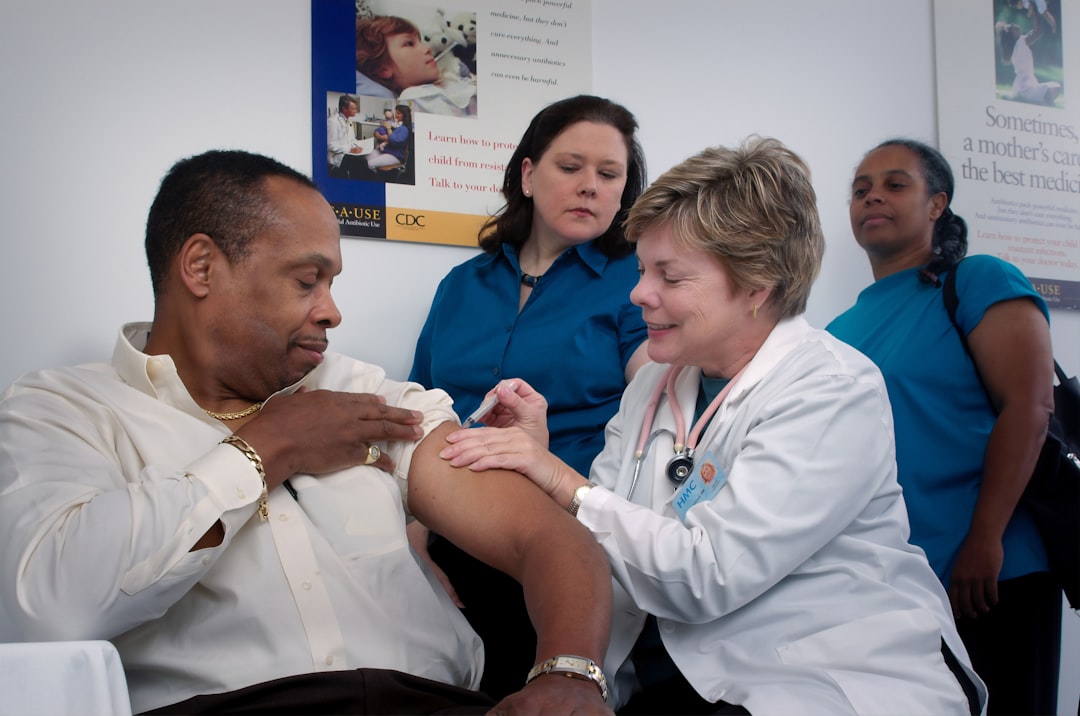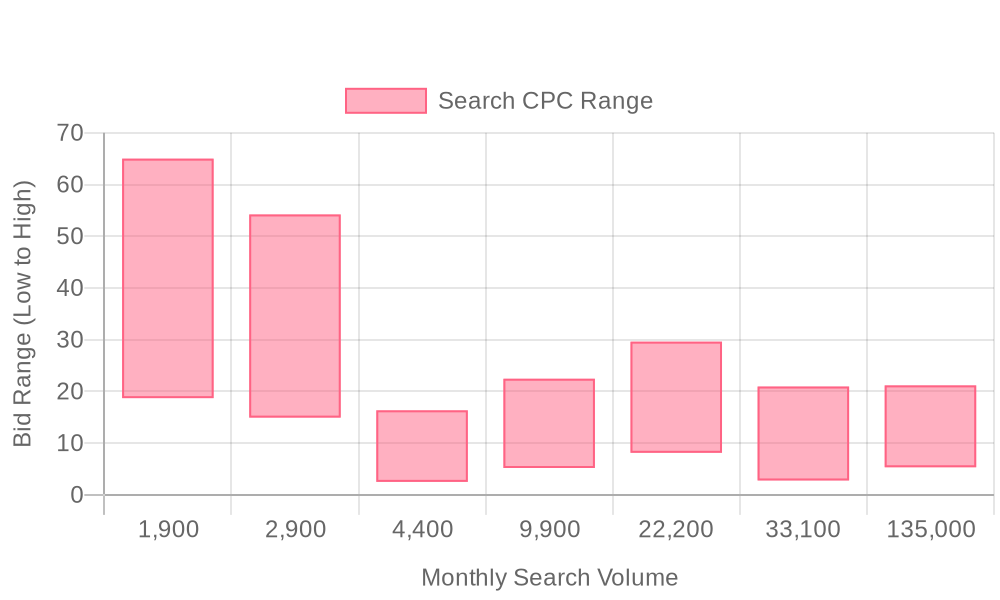
Supercharge your lead generation with a FREE Google Ads audit - no strings attached! See how you can generate more and higher quality leads
Get My Free Google Ads AuditFree consultation

No commitment
Supercharge your lead generation with a FREE Google Ads audit - no strings attached! See how you can generate more and higher quality leads
Get My Free Google Ads AuditFree consultation

No commitment
In the ever-evolving landscape of healthcare management, leveraging Google Ads effectively can make a significant impact on visibility and patient engagement. A major challenge faced by healthcare providers is the integration of online strategies with compliance requirements and specialized marketing needs. Google Ads allows healthcare businesses to capture high-intent prospects precisely when they need care or services, bridging the gap between awareness campaigns and patient conversions. This guide will explore how Google Ads can serve as a crucial component of healthcare providers' marketing strategies by targeting precise needs, ensuring compliance, and optimizing efforts to improve ROI.

Healthcare organizations face a unique set of challenges when generating high-quality leads through Google Ads. Effective strategies must bridge the gap between anonymous web traffic and qualified patient inquiries, while maintaining strict compliance and maximizing every marketing dollar. For a comprehensive overview on how doctors can use Google Ads to attract new patients and grow their practices, see this guide for doctors using Google Ads. To further enhance your understanding of effective lead generation, explore actionable B2B marketing playbooks.
A successful Google Ads for Healthcare Management approach requires advanced keyword and audience targeting. Healthcare marketers who leverage granular intent signals and real-time behavioral data can move beyond surface-level targeting to identify and engage prospects most likely to convert. Harnessing precise audience intelligence allows teams to pinpoint both individuals and organizations showing in-market intent, which dramatically improves the efficiency of ad spend.
Aligning landing pages and creative assets with ad intent is essential for conversion. Prospects who click on a healthcare ad expect a seamless experience—relevant content, intuitive navigation, and a clear path to action. With conversion rates hinging on these moments, optimizing landing pages with personalized messaging and dynamic content ensures that high-value interest does not go unconverted. Integration with advanced platforms enables marketers to track buyer journeys and tie every touchpoint back to individual journeys, making it possible to deliver timely follow-ups and prevent leads from cooling off.
Continuous optimization is the backbone of healthcare PPC strategies. By analyzing campaign performance, marketers can refine keyword bids, adjust audience parameters, and reallocate budget in real time to maximize results. Utilizing platforms that sync real-time audience data and conversion data between CRM and ad channels ensures campaign adjustments are always based on the most current information, which is critical for maintaining high ROI in healthcare digital marketing.
An integrated, omnichannel strategy is vital for sustained lead quality and volume. Syncing audience segments and conversion data across multiple platforms—including Google Ads, CRM, and marketing automation tools—enables healthcare teams to orchestrate timely follow-ups and nurture leads across every stage of the funnel. This unified approach not only enhances targeting precision, but also ensures marketing teams never miss a high-value opportunity due to data silos or lagging insights. By following these steps, healthcare practices and organizations can efficiently generate, engage, and convert patient leads while maintaining a strong compliance posture and optimizing for long-term growth. If you’re ready to elevate your healthcare lead generation, get started for free with Sona.

Healthcare organizations operate in a competitive, high-stakes environment where patient acquisition and retention are directly tied to the quality of digital outreach. Google Ads for Healthcare Management delivers unmatched speed and precision in connecting medical practices with patients who are actively seeking care, allowing providers to engage at moments of highest intent and need. For more actionable insights on data-driven marketing, visit our marketing analytics blog.
Ready to improve patient acquisition and campaign ROI? Get started for free with Sona.

Healthcare organizations drive measurable growth by aligning campaign types with each stage of the patient journey. Modern marketing teams benefit from diversified strategies that capture attention, nurture interest, and convert intent-driven prospects into scheduled appointments. By leveraging campaign customization and unified data, healthcare marketers can optimize every touchpoint for higher acquisition and retention. For a comprehensive overview of how doctors can utilize Google Ads to attract new patients, see this guide to Google Ads for doctors. To further refine your marketing programs, explore actionable insights on the Sona blog.
To start optimizing your healthcare campaigns and activate advanced audience targeting, get started for free with Sona.

Healthcare organizations seeking growth can accelerate results by moving beyond outdated marketing tactics and unlocking actionable visibility into anonymous traffic. By addressing the blind spots that traditional campaigns leave behind, teams can tap into richer audience data and uncover new avenues for engagement.
Ready to transform your healthcare ad strategy? Get started for free with Sona.
Audience segmentation is fundamental in healthcare digital marketing, ensuring campaigns reflect the diverse journeys patients take when seeking care. By abandoning blanket messaging and tailoring communication to nuanced needs, organizations gain stronger engagement and higher conversion rates across Google Ads for Healthcare Management initiatives. Using visitor identification intelligence, anonymous website traffic is transformed into actionable insights, allowing teams to drill down into company-level or demographic-specific interests before ads are delivered.

| Industry | Keyword | Monthly Search Volume | Competition Level | Low Bid | High Bid |
| Healthcare Management | bachelor's in healthcare administration | 1900 | MEDIUM | 18.7 | 65 |
| Healthcare Management | online master's in healthcare administration | 2900 | MEDIUM | 14.94 | 54.21 |
| Healthcare Management | revenue cycle management healthcare | 4400 | LOW | 2.51 | 16.35 |
| Healthcare Management | healthcare management | 9900 | MEDIUM | 5.2 | 22.45 |
| Healthcare Management | healthcare administration | 22200 | MEDIUM | 8.14 | 29.62 |
| Healthcare Management | revenue cycle management | 33100 | LOW | 2.79 | 20.94 |
| Healthcare Management | health information management | 135000 | LOW | 5.34 | 21.16 |
Precision in keyword strategy is foundational for healthcare organizations aiming to capture high-intent searchers and meet patient needs at the exact moment of care-seeking. By targeting terms such as “Google Ads for Healthcare Management,” “healthcare PPC strategies,” and “Google Ads for medical practices,” marketers can intercept motivated users actively researching providers, treatments, or telehealth services. For practical keyword inspiration and campaign tactics, review this guide on Google Ads for doctors. This approach transforms anonymous queries into actionable engagement opportunities, reducing wasted spend and elevating overall campaign efficiency.
Effective keyword strategies go beyond basic search intent by layering in negative keywords to eliminate irrelevant clicks and incorporating long-tail variations specific to specialties or localities, such as “urgent care near me” or “virtual cardiology consult.” Marketers who identify the intent behind each query are better positioned to present relevant information, guide prospects along the patient journey, and maintain compliance with healthcare advertising best practices. For expert guidance on healthcare marketing and analytics, explore the Sona blog.
Integrating Google Ads into a broader multi-channel healthcare digital marketing plan amplifies results. By unifying search, display, and retargeting campaigns, organizations can re-engage site visitors who have not converted and nurture them with targeted messaging. Platforms that enable Sona Identification allow marketers to move beyond anonymous web traffic, pinpointing accounts and decision-makers with real purchase intent. Real-time intent signals inform budget allocation, so high-converting audiences receive increased investment when they are most likely to engage. As leads progress through the funnel, dynamic audience segments update automatically, ensuring each ad touchpoint is personalized and timely. Ready to elevate your healthcare ad strategy? Get started for free with Sona.
Healthcare marketers achieve superior results when keyword lists are precisely structured around individual specialties and local market demands. By clustering keywords for cardiology, urgent care, telemedicine, or pediatric services and pairing them with regional modifiers, campaigns more effectively capture search intent from high-value prospects. This targeted approach reduces wasted spend and ensures ad budgets prioritize active, in-market patients rather than broad, low-converting queries.
Unified data platforms elevate keyword strategy by enabling marketers to pinpoint which companies and decision-makers are visiting their digital properties. Identifying visitors down to the organization and intent level allows for dynamic keyword expansion, ensuring campaigns adapt instantly as new high-intent leads emerge. Real-time audience data also empowers marketers to shift budget toward keywords aligned with accounts showing purchase readiness, maximizing campaign efficiency and healthcare PPC strategies.
Effective ad copy in healthcare must bridge the gap between patient pain points and the promise of care quality, clarity, and accessibility. Messaging that directly acknowledges patient concerns—such as rapid appointment scheduling, specialized treatment options, or trusted provider credentials—builds immediate credibility and trust. Moving beyond generic language, tailored copy addresses unique community health needs and fosters a stronger connection with prospective patients.
Data-driven creative testing further refines messaging by revealing which copy variations resonate best with different audiences and service lines. As enriched lead and visitor data syncs with ad platforms, marketers can dynamically adjust messaging based on real-time engagement trends or specific funnel stages. This level of alignment supports healthcare advertising best practices and increases the likelihood of meaningful patient conversions.
Conversion-focused landing pages are critical for bridging the last mile between ad click and valuable patient action. Each landing page should directly reflect the ad’s promise, featuring prominent trust markers such as provider certifications, patient testimonials, and clear privacy assurances. Fast-loading design, accessible navigation, and upfront explanations of next steps further reduce bounce rates and increase form completions for medical practices.
Integrating audience and behavioral data allows for adaptive content blocks—displaying the most relevant services, appointment types, or locations based on user segment or referral source. When CRM and ad data sync seamlessly, marketers can trigger personalized follow-up sequences for visitors who convert or retarget those who bounce, closing gaps in the patient acquisition journey and supporting Google Ads optimization for healthcare.
Continuous optimization ensures that healthcare campaigns not only reach the right prospects but also maximize ROI on every dollar spent. Advanced conversion tracking links both online and offline actions, such as appointment bookings and phone inquiries, to their originating ad campaigns. This granular attribution enables healthcare organizations to identify which channels, keywords, and creative assets truly drive patient acquisition and revenue.
Real-time insights from unified analytics platforms empower teams to rapidly adjust bidding strategies, audience segments, and creative assets as market conditions evolve. Automated audience syncing keeps retargeting lists and exclusion groups current, ensuring that nurture tactics remain relevant as leads progress through the funnel. These optimizations drive higher Google Ads ROI for healthcare, streamline budget allocation, and reinforce compliance by minimizing the risk of wasted spend on non-compliant or unqualified traffic. To see how advanced analytics can drive your next campaign, get started for free with Sona.

Promoting patient education and engagement through precision-targeted Google Ads campaigns allows healthcare organizations to transform anonymous website traffic into meaningful patient interactions. By building campaigns around high-intent educational content—such as wellness guides, preventive care resources, or new treatment options—clinics and health systems can deliver value to prospective patients at the research phase. When these campaigns are supported by robust visitor identification and real-time intent data, marketers can move beyond surface-level metrics and directly attribute ad engagement to specific organizations and patient demographics, making subsequent outreach more actionable. For a comprehensive overview on how doctors can use Google Ads to attract patients and grow their practices, explore this guide to Google Ads for doctors.
Upselling related healthcare services to existing patient audiences requires sophisticated segmentation and dynamic audience management. Healthcare teams can use dynamic audience management to deliver hyper-relevant messages, such as promoting physical therapy to recent surgical patients or offering telehealth follow-ups to ongoing care recipients. Automated audience updates ensure that as patients progress along their care journey, messaging remains timely and compliant. When enriched CRM data syncs seamlessly with advertising platforms, healthcare marketers can personalize offers and reminders, increasing both follow-up rates and overall engagement. Access more actionable strategies in our playbooks for B2B marketing.
Partnering with respected medical associations delivers instant credibility and widens your sphere of influence. Joint campaigns—such as co-hosted webinars or sponsored association newsletters—can be amplified using healthcare PPC strategies that target association members and their broader networks. Marketers overcome the common challenge of limited visibility into key prospects by leveraging platforms that reveal which organizations interact with ads. This insight allows for more effective follow-up, tailored nurturing, and strategic networking with decision-makers at scale. For more insights and updates on best practices, visit our marketing analytics blog.
Localized advertising remains the cornerstone of patient acquisition for clinics and medical practices. By refining Google Ads targeting for healthcare, providers can dominate high-value geographic markets, ensuring their services appear when and where patients are actively searching. Tailoring campaigns by zip code, city, or neighborhood allows for nuanced segmentation, enabling personalized ad creative that speaks to local health needs and regulatory nuances. When real-time intent signals and offline conversion tracking are integrated, it becomes possible to measure true ROI down to each market segment, ensuring that budget allocation and optimization efforts deliver measurable growth in patient acquisition and retention. If you're ready to implement these strategies, get started for free with Sona.
Successful execution of Google Ads for Healthcare Management hinges on data-driven strategies that align with the distinct intent signals patients send during their search journeys. Strategic keyword targeting remains the foundation: by analyzing search trends and intent-rich phrases, healthcare marketers can continually engage high-value prospects, ensuring that digital budgets are allocated where the probability of conversion is highest. When platforms like Sona are used to identify and prioritize in-market accounts, teams can dynamically adjust bids and messaging, streamlining patient acquisition and maximizing campaign efficiency.
Audience segmentation is crucial for addressing diverse healthcare needs and ensuring that each ad resonates with the right demographic or clinical segment. Segmentation prevents generic messaging that often leads to poor engagement and wasted spend. With dynamic audience capabilities, marketers can update segments in real time as leads progress through the funnel, allowing for highly personalized healthcare PPC strategies that adapt to patient behaviors, interests, and treatment timelines. This results in higher relevance, stronger trust, and improved ROI for healthcare providers.
High-converting creative is essential in healthcare advertising best practices. Ad copy must clearly communicate value propositions and critical service details, removing ambiguity that could lead to abandonment. Creative assets should reflect the urgency of care, the credibility of clinical offerings, and the accessibility of services. Incorporating real-time patient data and behavioral insights—captured through unified data platforms—enables marketers to tailor creative for each segment and trigger, significantly lifting conversion rates while maintaining compliance.
Continuous optimization, grounded in reliable patient data, allows healthcare organizations to refine their campaigns with precision. Real-time analytics and advanced attribution models measure not only digital conversions but also offline outcomes, such as scheduled appointments or calls. By integrating CRM and ad platforms, teams can sync enriched leads and track performance across touchpoints, ensuring that high-intent opportunities receive immediate and personalized follow-up. This approach reduces lag, increases conversion velocity, and ensures every patient journey is captured and improved upon.
By combining Google Ads with a healthcare-focused approach, providers can align their digital presence tightly with evolving patient demands. Leveraging integrated data, advanced targeting, and conversion intelligence, healthcare organizations can drive sustained growth and visibility, outpacing competitors in a crowded and regulated market. Real-time data orchestration and audience sync transform how providers engage, measure, and optimize their marketing investments, ensuring that every dollar spent delivers measurable impact in patient acquisition and brand reputation. Ready to see these strategies in action? Get started for free with Sona.
In conclusion, effectively utilizing Google Ads for healthcare management requires a strategic approach that balances visibility, patient engagement, and compliance. By understanding the unique challenges of the healthcare industry, such as strict regulatory requirements and the need for targeted outreach, you can create campaigns that not only enhance awareness but also build trust with potential patients.
Throughout this article, we've explored the critical aspects of leveraging Google Ads to promote healthcare services. From crafting compelling ad copy that resonates with your audience to utilizing advanced targeting options that ensure your ads reach the right people, each step is vital for driving successful outcomes. These strategies, when implemented thoughtfully, can lead to increased patient engagement and improved overall visibility for your healthcare services.
Imagine a scenario where your healthcare services are not only visible to a wider audience but also actively engaging with them in meaningful ways. With the right tools and knowledge, this transformation is within reach. Embrace the opportunity to refine your approach, stay compliant, and make a significant impact in your field.
To experience firsthand how a platform can unify your marketing efforts and provide actionable insights, start for free to explore the capabilities that await.
Best practices include advanced keyword and audience targeting, ensuring compliance, optimizing landing pages with personalized messaging, and continuously analyzing campaign performance for real-time adjustments.
Healthcare providers can effectively use Google Ads by aligning campaigns with patient journeys, utilizing advanced audience segmentation, leveraging real-time data for targeting, and integrating campaign efforts with CRM systems.
The article does not specify a budget range, but emphasizes the importance of optimizing ad spend by focusing on high-intent prospects and adjusting budgets based on real-time data insights.
Healthcare marketers must ensure ads comply with industry regulations, highlight key differentiators like credentials and insurance acceptance, and maintain ad relevance and compliance as service offerings change.
Success can be measured by tracking conversion rates, integrating CRM data, analyzing closed-loop analytics for online and offline conversions, and using real-time analytics and attribution models to refine campaigns.
Join results-focused teams combining Sona Platform automation with advanced Google Ads strategies to scale lead generation

Connect your existing CRM

Free Account Enrichment

No setup fees
No commitment required

Free consultation

Get a custom Google Ads roadmap for your business
Join results-focused teams using Sona Platform automation to activate unified sales and marketing data, maximize ROI on marketing investments, and drive measurable growth

Connect your existing CRM

Free Account Enrichment

No setup fees
No commitment required

Free consultation

Get a custom Google Ads roadmap for your business
Over 500+ auto detailing businesses trust our platform to grow their revenue
Join results-focused teams using Sona Platform automation to activate unified sales and marketing data, maximize ROI on marketing investments, and drive measurable growth

Connect your existing CRM

Free Account Enrichment

No setup fees
No commitment required

Free consultation

Get a custom Google Ads roadmap for your business
Over 500+ auto detailing businesses trust our platform to grow their revenue
Join results-focused teams using Sona Platform automation to activate unified sales and marketing data, maximize ROI on marketing investments, and drive measurable growth

Connect your existing CRM

Free Account Enrichment

No setup fees
No commitment required

Free consultation

Get a custom Google Ads roadmap for your business
Over 500+ auto detailing businesses trust our platform to grow their revenue
Join results-focused teams using Sona Platform automation to activate unified sales and marketing data, maximize ROI on marketing investments, and drive measurable growth

Connect your existing CRM

Free Account Enrichment

No setup fees
No commitment required

Free consultation

Get a custom Google Ads roadmap for your business
Over 500+ auto detailing businesses trust our platform to grow their revenue
Our team of experts can implement your Google Ads campaigns, then show you how Sona helps you manage exceptional campaign performance and sales.
Schedule your FREE 15-minute strategy sessionOur team of experts can help improve your demand generation strategy, and can show you how advanced attribution and data activation can help you realize more opportunities and improve sales performance.
Schedule your FREE 30-minute strategy sessionOur team of experts can help improve your demand generation strategy, and can show you how advanced attribution and data activation can help you realize more opportunities and improve sales performance.
Schedule your FREE 30-minute strategy sessionOur team of experts can help improve your demand generation strategy, and can show you how advanced attribution and data activation can help you realize more opportunities and improve sales performance.
Schedule your FREE 30-minute strategy sessionOur team of experts can help improve your demand generation strategy, and can show you how advanced attribution and data activation can help you realize more opportunities and improve sales performance.
Schedule your FREE 30-minute strategy session





Launch campaigns that generate qualified leads in 30 days or less.
